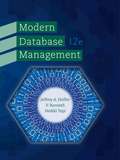
Concept explainers
Define the following terms: Dynamic SQL, Correlated subquery, embedded SQL, procedure, join, equi-join, self-join, outer join, function, and persistent stored modules (SQL/PSM).
Explanation of Solution
Dynamic SQL: Dynamic SQL is the
Correlated subquery: In SQL correlated subquery is subquery in which the processing of inner query depends on the outer query. While in a normal nested query the inner query is executed first and then the outer query is executed, in case of correlated query inner query is executed once for each row considered by outer query.
Embedded SQL: Embedded SQL is the practice of combining the capability to programming languages and SQL statements to perform
Procedure: An SQL procedure is the stored SQL code containing multiple SQL statements which can be reused over and over again to perform some redundant task in the database.
Join: An SQL join refers to combination or two or more rows or columns from one or more tables in the database to create a temporary table. There are various kind joins such as equi join, self join, natural join, outer join, inner join etc.
Equi-join: It is a type of join in which the condition of joining is based on the equality between the values in common columns. Common columns are redundant in the resulting table in case of equi-join. For illustration purpose, consider the table below:
| Table order | |
| CustID | OrderID |
| 100 | 502 |
| 101 | 206 |
| 102 | 205 |
| 103 | 1225 |
| Table customer | |
| CustID | CustName |
| 100 | John |
| 101 | Paul |
| 102 | Smith |
| 103 | Jason |
For the above two tables on performing the equi join by the following SQL query:
SELECT Customer.CustID, Order.CustID,
CustName, OrderID
FROM Customer, Order
WHERE Customer.CustID = Order. CustID
ORDER BY OrderID
The resulting table will contain the following data:
| CustID | CustID | CustName | OrderID |
| 100 | 100 | John | 502 |
| 101 | 101 | Paul | 206 |
| 102 | 102 | Smith | 205 |
| 103 | 103 | Jason | 1225 |
Self-join: Self-join is the join in which table rows are matched with other rows of the same table. In short self-join can be termed as joining the table with itself. Self-join can be used to generate a sub table from a given large table. The syntax for performing self-join is as follows:
SELECT B1.column_name, B2.column_name...
FROM table1 X, table1 Y
WHERE B1.common_filed = B2.common_field;
Outer join: It is a join in which resulting table consists of matching rows from the joined table as well as non-matching rows based on the join condition. The syntax of using outer join is as follows:
Select *
FROM table1, table2
WHERE conditions [+];
Function: A function in SQL is a stored subroutine that takes one parameter as input and returns one value. They are similar to procedure except that they can only exercise one input parameter. There are many built in functions in SQL such as SUM, AVG, and COUNT.
Persistent stored modules (SQL/PSM): PSM or persistent stored module is the additional capability added in the SQL in 1999. These capabilities allowed programmer to create and drop modules of codes stored in the database schema across user session. It also gave SQL computational power and flow control capabilities such as IF-THEN, FOR, WHILE statements and loops.
Want to see more full solutions like this?
Chapter 7 Solutions
EBK MODERN DATABASE MANAGEMENT
 Database System ConceptsComputer ScienceISBN:9780078022159Author:Abraham Silberschatz Professor, Henry F. Korth, S. SudarshanPublisher:McGraw-Hill Education
Database System ConceptsComputer ScienceISBN:9780078022159Author:Abraham Silberschatz Professor, Henry F. Korth, S. SudarshanPublisher:McGraw-Hill Education Starting Out with Python (4th Edition)Computer ScienceISBN:9780134444321Author:Tony GaddisPublisher:PEARSON
Starting Out with Python (4th Edition)Computer ScienceISBN:9780134444321Author:Tony GaddisPublisher:PEARSON Digital Fundamentals (11th Edition)Computer ScienceISBN:9780132737968Author:Thomas L. FloydPublisher:PEARSON
Digital Fundamentals (11th Edition)Computer ScienceISBN:9780132737968Author:Thomas L. FloydPublisher:PEARSON C How to Program (8th Edition)Computer ScienceISBN:9780133976892Author:Paul J. Deitel, Harvey DeitelPublisher:PEARSON
C How to Program (8th Edition)Computer ScienceISBN:9780133976892Author:Paul J. Deitel, Harvey DeitelPublisher:PEARSON Database Systems: Design, Implementation, & Manag...Computer ScienceISBN:9781337627900Author:Carlos Coronel, Steven MorrisPublisher:Cengage Learning
Database Systems: Design, Implementation, & Manag...Computer ScienceISBN:9781337627900Author:Carlos Coronel, Steven MorrisPublisher:Cengage Learning Programmable Logic ControllersComputer ScienceISBN:9780073373843Author:Frank D. PetruzellaPublisher:McGraw-Hill Education
Programmable Logic ControllersComputer ScienceISBN:9780073373843Author:Frank D. PetruzellaPublisher:McGraw-Hill Education





